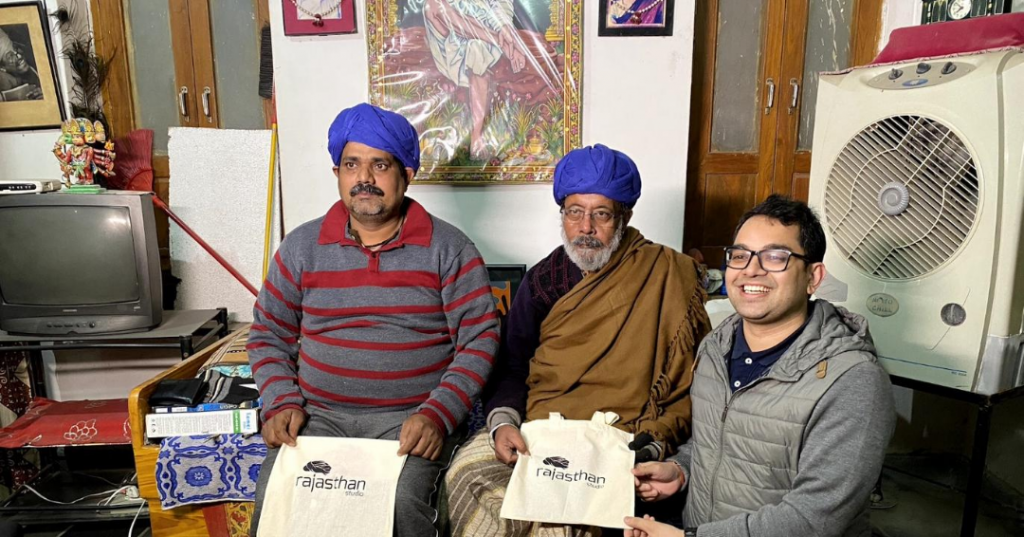
Phad Painting – A DIY Guide To India’s Dying Folk Art
A Phad painting is a popular Rajasthani folk painting style that features stories of the Gods Devnarayan and Pabuji. While the art form was entirely dedicated to these gods in the earlier days, today, modifications have been made to include stories from other mythologies, like the Ramayana and Mahabharata.
Hindus are deeply religious people. A bhakt is inseparable from his God. And the public manifestation of this relationship happens in temples. This is the reason there are so many of them in India, and every popular monument that you visit has its own place of worship.
But what if you lead a nomadic lifestyle and don’t know where you will put up next? How then do you go about finding a temple to offer prayers, an indispensable ritual of Hindu life? This was the predicament that the members of the Rabari tribe found themselves in, quite often.
That’s when the Bhopas, or priests, decided to bring the Gods to this wandering group, in the form of travelling temples. They started travelling with Phad paintings to wherever the Rabaris camped and enacted the stories that were depicted in them. Just as woven wall tapestries depict a religious scene from Christian culture, a Phad painting brings to you a soulful tale from the Hindu Gods on a piece of cloth.

More about Phad painting
This peculiar art form is painted on a long cloth called Phad, using colours from natural resources. Each Phad tells a story, in the form of a series of paintings.
The most distinguishing characteristic of Phad is that the figures are always only facing each other. No figure will ever face you. And the eyes bring each character to life. The size of each participant in the painting is different, depending on the role that person played in the story you are depicting.
You can’t just start making a Phad painting. It requires pre-preparation. You first need to stiffen a piece of cotton cloth with starch, that is made from glue and boiled flour. A stone called ’mohra’, or a glass paperweight is then used to polish it by rubbing vigorously. This cloth then acts as your canvas and is called your Phad.
Having said that, once your canvas is ready, it’s not very tough to make the actual painting. But it does require patience and precision. Haste makes waste. So be ready to spend a sufficient amount of time on your next masterpiece. The end result will be worth it.
What do you need to make a Phad painting?
- Brushes
- Phad, which is your canvas
- Natural colours based on your preference
The Painting Method
- Pick a short story of your choice from your favourite mythology. It can be as simple as a conversation between characters. For starters, pick an incident involving just two people, a man and a woman. This will give you an idea of how to paint a figure from each of the two sexes.
- Draw the two figures with a very light hand, using a not-so-dark pencil.
- Draw the accessories and clothes for each of the two figures. Leave out the eyes. That will be done in the end.
- Use a light orange colour to paint the skin of the figures.
- Paint the clothes green. Leave out the detailed designs. Different colours will be used for those.
- Use a bright yellow colour for the jewellery, vessels, and instruments.
- Use royal blue for the details on the clothes, including the designs and embroidery.
- Paint the eyes. These are the most distinguishing features of the painting. Be very careful with them. Draw fine lines with the appropriate curve and heaviness to give the look of a typical Phad painting.
- Use red paint if you need to add further details to the clothes and instruments.
- Give a black outline to the entire picture using a thin brush or a micro tip pen. You can also use a thin black sketch-pen.
- If you need to depict a bigger story, you can add more figures using the same colour scheme, in a sequence of scenes. Just make sure that all the figures face each other.
Your very first Phad painting is ready!
Phad painting was originally created only by the members of the Joshi family, who belonged to the Chipa caste, near Bhilwara, in Shahpura, Rajasthan, over 700 years ago. It was passed along generations within the family. But as time passed, fewer members stayed interested in pursuing this beautiful art and moved on to other things. As a result, the art form struggled for its survival.
The Joshi family slowly opened its doors to outsiders to keep the tradition alive.
If you’ve enjoyed working on your Phad painting and would like to learn more about it from the pioneers in the industry, book a session with us here. You’ll get a chance to learn from the Shilp Guru Award recipient, Pradeep Mukherjee, India’s first miniature Phad artist, and his disciple of twenty-five years, Shamsher Khan.
Conclusion
It’s not every day that you get to learn from the people who are passionate about what they do. At Rajasthan Studio, we bring to you workshops from experts who have dedicated their entire lives to the fine arts. And if they could do it all over again, they wouldn’t change a thing.

Did you enjoy reading this article? Let us know in the comment section!
Also follow Rajasthan Studio on Instagram for more amazing art and travel content. Reach out to us on email at contact[at]rajasthanstudio[dot]com. This blog is curated Rajasthan Studio and written by Sneha Modi.

























